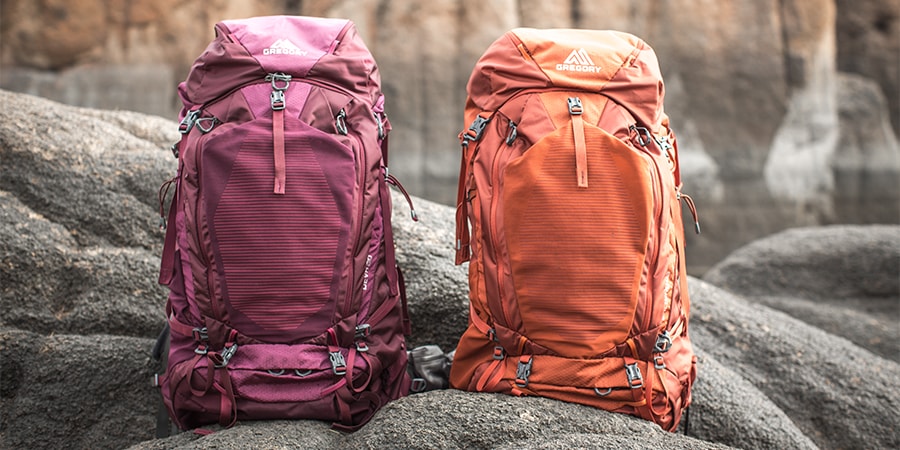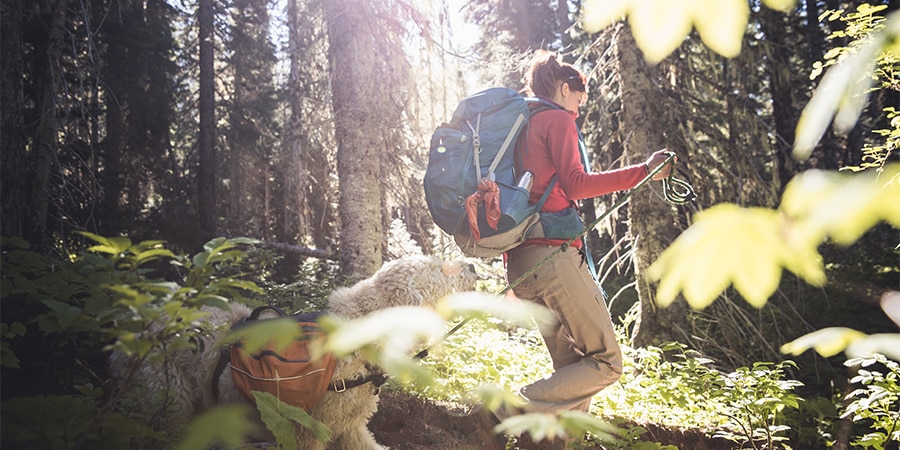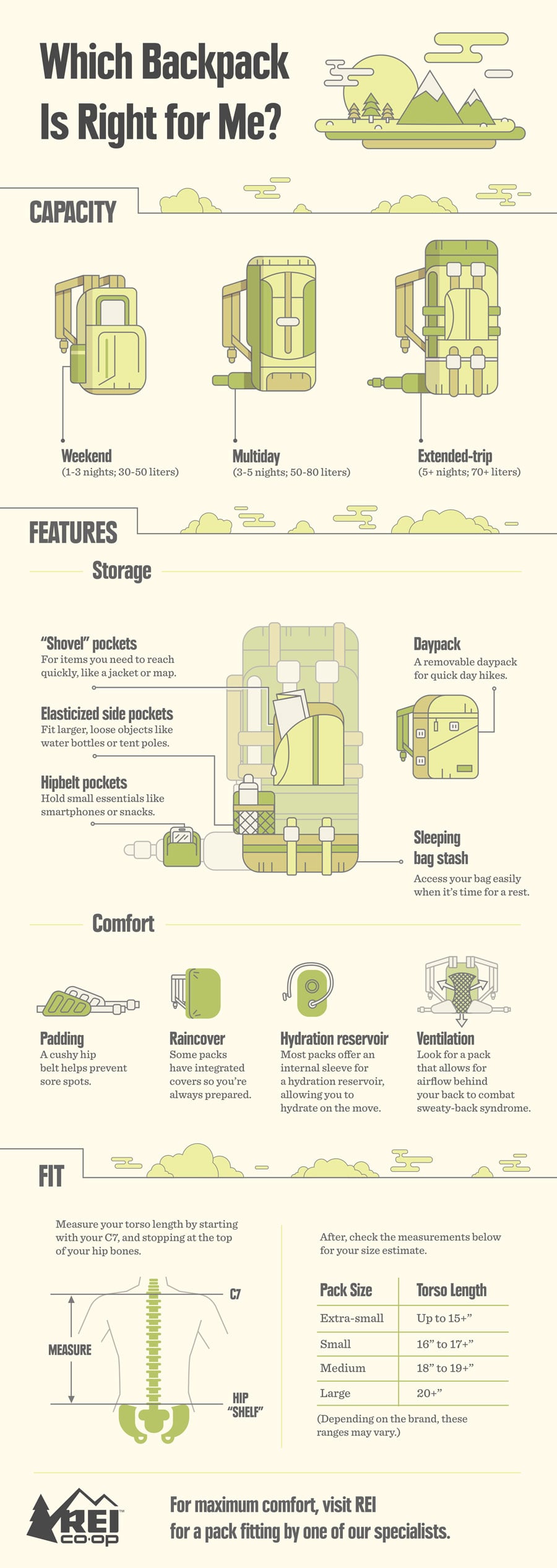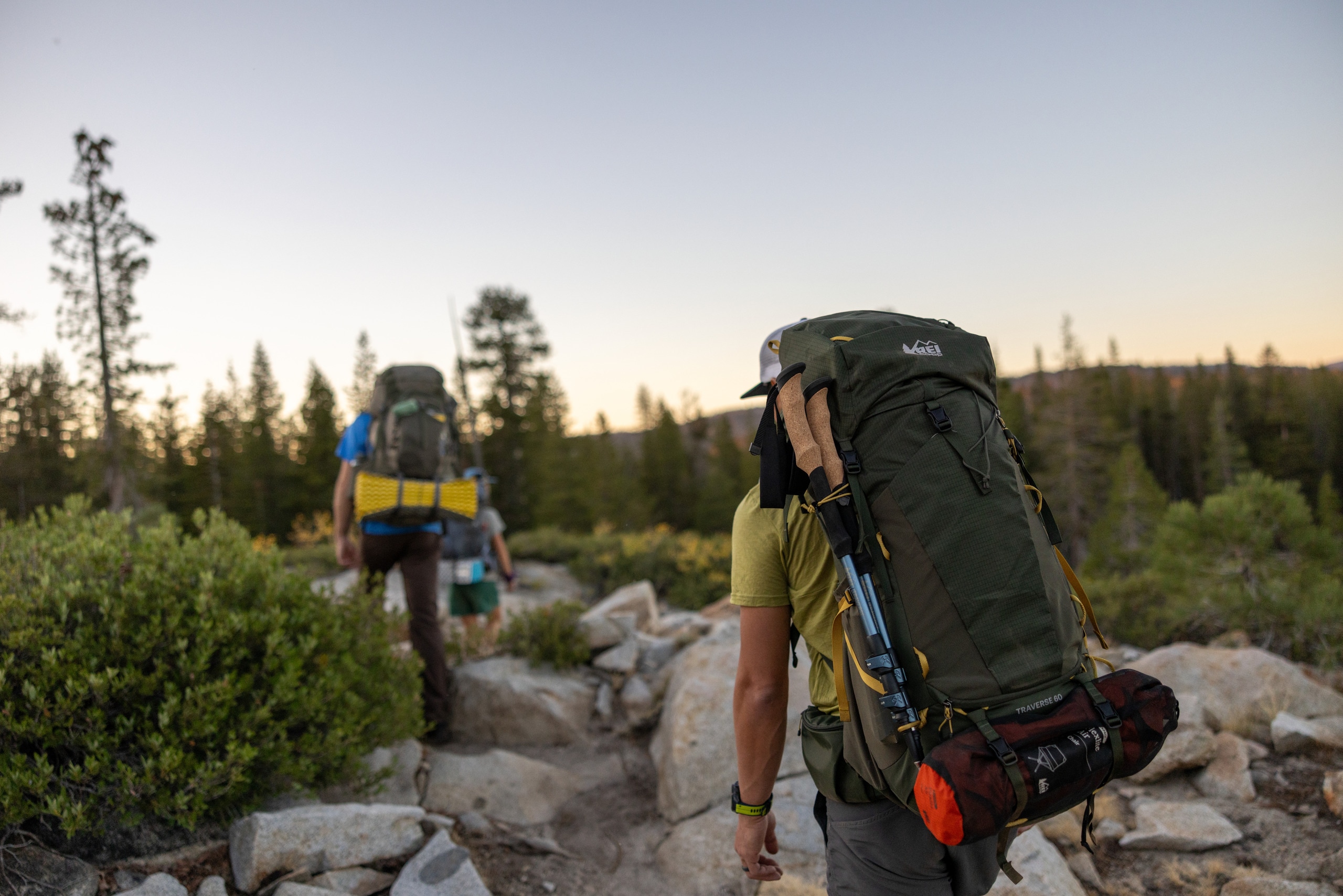Planning to buy a new pack for backpacking? There are three main areas where you'll need to make choices if you want a pack for overnight or multiday trips. Backpacking packs are designed to haul a heavy load and have features that make it easy to stash food, gear like sleeping bags and tents, and clothes.
- Backpack capacity: The size of the pack you'll need is tied to the length of your trip and how much weight and bulk you want to carry. Most backpacking packs start at about 45 liters and can range to 80 liters.
- Backpack features: These refinements affect how the pack works for you, like pockets, sleeping bag compartments, raincover, removable day packs and more.
- Backpack fit: Torso length—not your height—matters most.
Video: How to Choose Backpacking Packs
Types of Backpacks

Weekend (1-3 nights; 30-50 liters)
Efficient packers using newer, less-bulky gear can really keep things light on 1- to 3-night trips by using a backpack in this range. Be aware that packing light requires self-discipline and careful planning. If you can pull it off, though, the light-on-your-feet rewards are fantastic. Shop weekend packs.
Multiday (3-5 nights; 50-80 liters)
These are the most popular backpacking packs sold at REI and they're an excellent choice for warm-weather trips lasting 3 or more days. Packs in the 50- to 80-liter range are also great for shorter trips where you pack a little more luxuriously or multisport activities like backcountry skiing. Shop multiday packs.
Extended-trip (5+ nights; 70 liters or larger)
Trips of 5 days or more usually call for packs of 70 liters or more. These are also usually the preferred choice for winter treks lasting more than 1 night. (Larger packs can more comfortably accommodate extra clothing, a warmer sleeping bag and a 4-season tent, which typically includes extra poles.) They're also a good option for folks taking young children backpacking because Mom and Dad wind up carrying a lot of kids' gear. Shop extended-trip packs.
Going ultralight? See our article on Ultralight Backpacking.
Backpack Features

Frame Type
- Internal frame backpacks: The majority of packs sold at REI today are body-hugging, internal frame packs where the structure is hidden inside the back panel. They are designed to keep a hiker stable on uneven, off-kilter terrain and may incorporate a variety of load-support technologies that all function to transfer the load to the wearer's hips.
- External frame backpacks: With an external frame pack, you can see the structure that supports the load: aluminum (usually) hardware on the outside. Because the frame extends beyond the packbag, a backpack like this may be an appropriate choice if you're carrying a heavy, irregular load (like an oversize tent or inflatable kayak). External frame packs also offer good ventilation and lots of gear organization options.
- Frameless backpacks: Ultralight devotees who like to hike fast and light might choose a frameless pack or a climbing pack where the frame is removable for weight savings. But packs without a frame are much more uncomfortable under heavy loads.
Ventilation
Some packs feature a suspended mesh back panel to combat the sweaty-back syndrome you tend to get with internal-frame packs that ride against your body. Also called a "tension-mesh suspension," this is a trampoline-like design where the frame-supported packbag rides a few inches away from your back, which instead rests against the highly breathable mesh. Other packs will have ventilation channels (sometimes called "chimneys") in the back panel to solve the same issue.
Pack Access
Top-loading openings are pretty standard. Since items near the bottom and sides are the toughest to get to, smart packers will store overnight gear there and stuff they need for hiking or throughout the day closer to the top. Some packs, however, have panel access, so you can unzip the main pack bag without unloading it from the top. Keep in mind that additional features like this tend to add both ounces and dollars.
Pockets
Some people like lots, and some people prefer a more streamlined pack. When evaluating pockets, consider the size and placement of each. For instance, elasticized side pockets lie flat when empty, but stretch out to hold a water bottle, tent poles or other loose objects. They can often be reached when wearing the pack. Hipbelt pockets accommodate small items you want while hiking like a phone, snacks, lip balm or sunscreen. Shovel pockets are basically flaps stitched onto the front of a packbag with a buckle closure at the top. Originally intended to hold a snow shovel, they now pop up on many 3-season packs, serving as stash spots for a map, jacket or other loose, lightweight items.
The top lid pocket (sometimes called a pack's "brain") is also a matter of preference. Some folks like a single opening for things like sunglasses and a headlamp, while others prefer a top lid with multiple compartments.
Removable Daypack
Some packs are designed with a removal daypack that is perfect for shorter trips from camp like summit bids or supply runs during a thru-hike. This removable daypack is often designed in the top lid or reservoir pocket of the overnight pack: It detaches from the main pack and converts into a hipbelt pack or lightweight backpack.
Sleeping Bag Compartment
This is a zippered stash spot near the bottom of a packbag. It's a useful feature if you don't want to use a stuff sack for your sleeping bag or if you want to be able to pull your sleeping bag out of the backpack without unloading other gear. Though it's designed to carry a sleeping bag, this space can hold other stuff that you'd like to access easily.
Padding
If you're using a lightweight pack with a fairly minimalistic hipbelt and lumbar pad, you can suffer sore spots on your hips, lower back or shoulders. If this is the case for you, consider using a cushier hipbelt. (First, make sure your pack is sized and fit correctly.)
Attachment Points
If you frequently travel with an ice axe or trekking poles, look for tool loops that allow you to attach them to the exterior of the pack. (Rare is the pack that does not offer at least a pair of tool loops.) You might also look for the following:
- Daisy chain: This is a length of webbing stitched to the outside of a pack that provides multiple gear loops for attaching a helmet, tools, wet gear or anything that didn't fit inside the main packbag.
- Reinforced crampon patch: This burlier piece of fabric prevents crampon points from gouging holes in the packbag.
- Extra gear loops: Gear loops on the hipbelt or low on the pack body are useful for clipping extra gear, especially oversize items like skis.
Raincover
If you expect rain on your trip, this is a good item to carry. Pack fabric interiors are usually treated with a waterproof coating, but water can seep through seams and zippers. Also, the fabric's exterior absorbs some water weight during a downpour.
An alternative: bundling gear internally in waterproof stuff sacks. Lightweight stuff sacks can be a better option in windy conditions because strong gusts can peel a cover right off a pack. (DIY version: Line the inside of your backpack with a plastic garbage bag.)
Hydration Reservoir
Nearly all packs offer an internal sleeve that holds a hydration reservoir (almost always sold separately), plus one or two portals for the tube.
Backpack Fit

Once you've chosen the type of backpack you want, it's time to fit your pack. It should be correctly sized for your torso length (not your overall height) and hip circumference. An REI sales specialist can help you do this, or you can enlist a friend and follow the directions provided in our article on Finding Your Torso and Hip Size.
Torso Length
Some packs are available in multiple sizes, from extra small to large, which fit a range of torso lengths. These ranges vary by manufacturer and by gender. Check the product specs tab for size details of a specific pack. Many packs also feature an adjustable suspension, which can be modified to fit your torso, especially if you're between sizes. (They're also a good option for folks who may share a pack among family members.) The drawback: An adjustable harness adds weight to a pack.
Waist Size
The majority of a backpack's weight—80 percent or more—should be supported by your hips. Backpack hipbelts usually accommodate a wide range of hip circumferences, from mid-20 inches to mid-40 inches or so. People with narrow waists sometimes find they cannot make a standard hipbelt tight enough and need to buy a smaller size. Some packs offer interchangeable hipbelts, making it possible to swap out one for another.
Women-Specific Backpacks
Because they have smaller frame sizes, women-specific backpacks often work well for young or shorter backpackers. The torso dimensions are generally shorter and narrower than in men's packs. Another thing to note is that the hipbelts and shoulder straps in women-specific packs tend to be contoured to accomodate wider hips and breasts.
Youth-Specific Backpacks
These typically offer smaller capacities and include an adjustable suspension to accommodate a child's growth. Women's backpacks, with their smaller frame sizes, often work well for young backpackers. So do small versions of some men's packs.
Additional Backpack Fit Adjustments
- Load-lifter straps: There are two. Each is attached to the top of the pack frame and stitched into the top of the shoulder straps. When you cinch them while wearing the pack, they will snug the top of the pack in closer to your body, which should lead to a more comfortable carry and get the weight off your lumbar. Ideally, the load lifters will form a 45-degree angle between your shoulder straps and the pack.
- Sternum strap: This strap crosses your chest, allowing you to connect the shoulder straps, which can boost your stability. It can be useful when traveling on uneven, cross-country terrain where an awkward move could cause your pack to shift abruptly and throw you off-balance.

